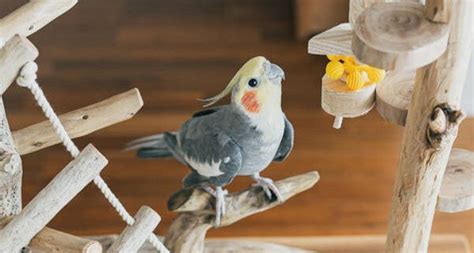Introduction
Birds, with their vibrant plumage, enchanting songs, and agile movements, bring immense joy and companionship to avian enthusiasts. Recognizing their innate need for physical and mental stimulation, bird owners are increasingly embracing the importance of providing their feathered friends with ample opportunities for exercise and environmental enrichment. This article delves into the crucial role these elements play in enhancing bird health, happiness, and overall well-being.

Importance of Bird Exercise
Physical Health
Exercise is paramount for bird health, fostering strong muscles, bones, and joints. Regular physical activity:
- Burns calories: Prevents obesity, a common health issue in captive birds.
- Improves circulation: Enhances cardiovascular function and oxygen delivery throughout the body.
- Strengthens bones: Reduces the risk of osteoporosis and fractures.
- Boosts immunity: Released endorphins during exercise have immune-enhancing effects.
Mental Health
Beyond physical benefits, exercise is essential for bird mental well-being. Active birds are:
- Less stressed: Exercise outlets pent-up energy, preventing anxiety and behavioral problems.
- More playful: Physical activity releases dopamine, a neurotransmitter associated with pleasure and reward.
- Sharper: Exercise stimulates brain development and cognitive function.
- Better sleepers: Tired birds sleep more soundly and restfully.
Essential Elements of Environmental Enrichment
Physical Enrichment
Physical enrichment provides opportunities for birds to explore, play, and express their natural behaviors. Essential elements include:
- Spacious cages/aviaries: Allow birds to move around freely and engage in natural behaviors like flying, perching, and foraging.
- Interactive toys: Stimulate birds mentally and encourage physical activity. Examples include foraging toys, climbing ladders, and swing perches.
- Natural perches: Different textures and diameters help maintain foot health and prevent boredom.
- Hiding places: Provide secure shelters for birds to retreat to when feeling stressed or vulnerable.
Sensory Enrichment
Sensory enrichment engages a bird’s senses, stimulating their curiosity and preventing sensory deprivation. This can include:
- Varied lighting: Mimic natural day/night cycles and provide different ambient light levels.
- Multisensory toys: Appeal to different senses, such as sight, sound, touch, and smell.
- Music and nature sounds: Provide calming or stimulating auditory experiences.
- Natural scents: Introduce safe and non-toxic plants or essential oils to enrich olfactory senses.
Social Enrichment
Birds, by nature, are social creatures. Providing opportunities for companionship and social interaction is crucial for their well-being:
- Pairing: House birds in compatible pairs or small groups to promote social bonding.
- Mirrors: While not a substitute for real companionship, mirrors can provide stimulation and mimic social interactions.
- Supervised interaction: Allow birds to socialize with humans through supervised handling and playtime.
Strategies for Providing Enriched Environments
Assessment and Individualization
Understanding each bird’s specific needs is essential. Observe their behaviors, energy levels, and preferences. Tailor enrichment strategies accordingly.
Gradual Introduction
Introduce new enrichment elements gradually to prevent overwhelming birds. Start with simple activities and gradually increase complexity and intensity.
Variety and Rotation
Avoid monotony by providing a variety of enrichment options. Regularly rotate toys and activities to maintain interest and prevent boredom.
Safety and Supervision
Ensure all enrichment items are safe and appropriate for the species. Monitor birds during playtime to ensure they are not engaging in dangerous behaviors.
Monitoring and Evaluation
Regularly observe birds to assess the effectiveness of enrichment strategies. Adjust and refine based on their responses and well-being.
Economic Impact and Market Insights
The growing awareness of bird health and well-being has spurred the expansion of the bird enrichment market. According to industry reports, the global bird toys and enrichment products market is projected to reach USD 2.5 billion by 2025. This growth is driven by:
- Increasing pet ownership
- Rising demand for high-quality bird care products
- Technological advancements and innovative enrichment solutions
Future Trends and Market Opportunities
The future of bird enrichment holds promising opportunities:
- Smart bird toys: Interactive toys with built-in sensors and technology that track bird activity and adjust difficulty levels.
- Personalized enrichment plans: Data-driven recommendations based on individual bird preferences and history.
- Virtual enrichment: Immersive virtual experiences that provide sensory stimulation and cognitive challenges.
Reviews
“Enriching my bird’s environment has made a world of difference. He is more active, playful, and seems much happier.” – Bird owner, San Francisco
“I have noticed a significant reduction in stress-related behaviors in my bird since implementing environmental enrichment.” – Avian veterinarian, Boston
“The bird enrichment industry is constantly evolving, providing pet owners with exciting new ways to keep their feathered friends stimulated.” – Industry analyst, New York
“As the popularity of bird keeping continues to grow, the demand for innovative and effective enrichment solutions will only increase.” – Market researcher, London
Conclusion
Exercise and environmental enrichment are indispensable elements for the well-being of captive birds. By providing birds with opportunities for physical activity, mental stimulation, and social interaction, avian owners can create flourishing and fulfilling environments for their feathered companions. The burgeoning bird enrichment market offers a wealth of innovative solutions, and the future holds exciting developments that will continue to enhance the quality of life for pet birds worldwide.





















